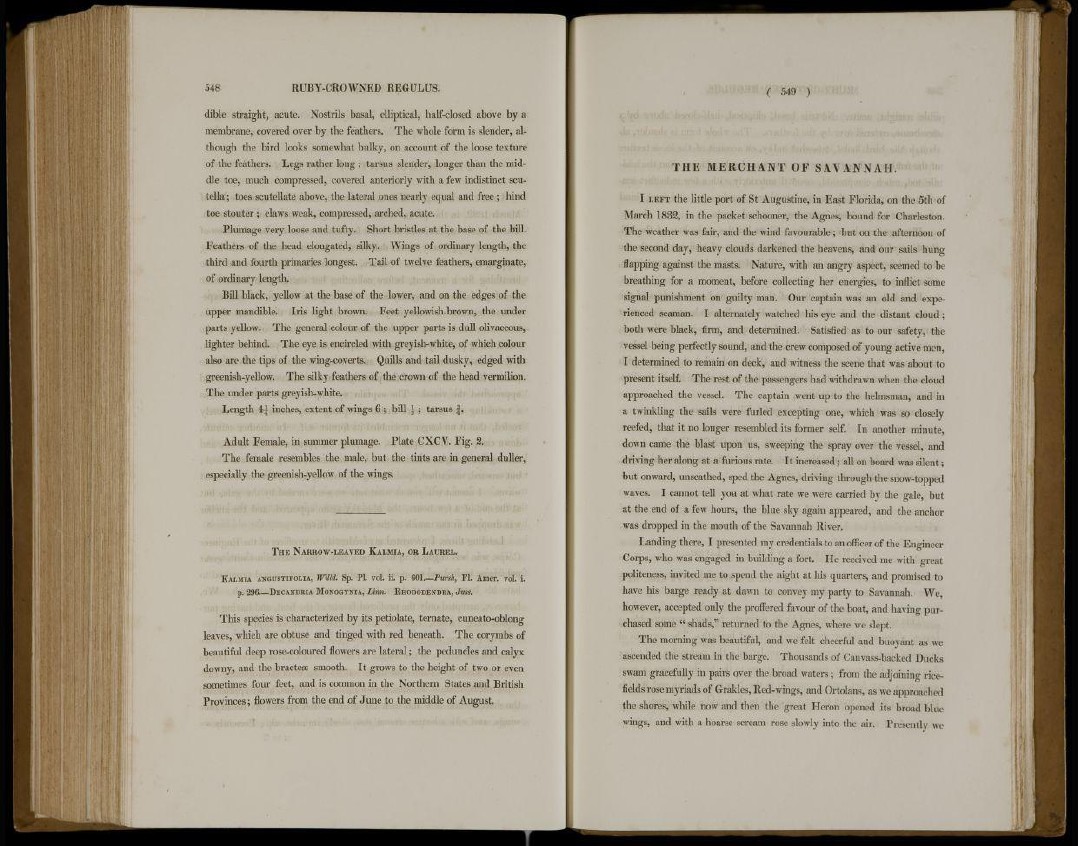
548 R U B Y - C R O W N E D R E G U L U S .
dible straight, acute. Nostrils basal, elliptical, half-closed above by a
membrane, covered over by the feathers. The whole form is slender, although
the bird looks somewhat bulky, on account of the loose texture
of the feathers. Legs rather long ; tarsus slender, longer than the middle
toe, much compressed, covered anteriorly with a few indistinct scutella;
toes scutellate above, the lateral ones nearly equal and free ; hind
toe stouter ; claws weak, compressed, arched, acute.
Plumage very loose and tufty. Short bristles at the base of the bill.
Feathers of the head elongated, silky. Wings of ordinary length, the
third and fourth primaries longest. Tail of twelve feathers, emarginate,
of ordinary length.
Bill black, yellow at the base of the lower, and on the edges of the
upper mandible. Iris light brown. Feet yellowish-brown, the under
parts yellow. The general colour of the upper parts is dull olivaceous,
lighter behind. The eye is encircled with greyish-white, of which colour
also are the tips of the wing-coverts. Quills and tail dusky, edged with
greenish-yellow. The silky feathers of the crown of the head vermilion.
The under parts greyish-white.
Length 4 | inches, extent of wings 6 ; bill I ; tarsus f.
Adult Female, in summer plumage. Plate CXCV. Fig. 2.
The female resembles the male, but the tints are in general duller,
especially the greenish-yellow of the wings.
THE NARROW-LEAVED KALMIA, OR LAUREL,
KALMIA ANGUSTEFOLIA, Willd. Sp. PI. vol. ii. p. C01.—Pursh, Fl. Amer. vol. i.
p. 296.—DECANDRIA MONOGYNIA, Linn. RHODODENDRA, JUSS.
This species is characterized by its petiolate, ternate, cuneato-oblong
leaves, which are obtuse and tinged with red beneath. The corymbs of
beautiful deep rose-coloured flowers are lateral; the peduncles and calyx
downy, and the bracteos smooth. It grows to the height of two or even
sometimes four feet, and is common in the Northern States and British
Provinces; flowers from the end of June to the middle of August.
( 549 )
T H E MERCHANT OF SAVANNAH.
I LEFT the little port of St Augustine, in East Florida, on the 5th of
March 1832, in the packet schooner, the Agnes, bound for Charleston.
The weather was fair, and the wind favourable ; but on the afternoon of
the second day, heavy clouds darkened the heavens, and our sails hung
flapping against the masts. Nature, with an angry aspect, seemed to be
breathing for a moment, before collecting her energies, to inflict some
signal punishment on guilty man. Our captain was an old and experienced
seaman. I alternately watched his eye and the distant cloud ;
both were black, firm, and determined. Satisfied as to our safety, the
vessel being perfectly sound, and the crew composed of young active men,
I determined to remain on deck, and witness the scene that was about to
present itself. The rest of the passengers had withdrawn when the cloud
approached the vessel. The captain went up to the helmsman, and in
a twinkling the sails were furled excepting one, which was so closely
reefed, that it no longer resembled its former self. In another minute,
down came the blast upon us, sweeping the spray over the vessel, and
driving her along at a furious rate. It increased; all on board was silent;
but onward, unscathed, sped the Agnes, driving through the snow-topped
waves. I cannot tell you at what rate we were carried by die gale, but
at the end of a few hours, the blue sky again appeared, and the anchor
was dropped in the mouth of the Savannah River.
Landing there, I presented my credentials to an officer of the Engineer
Corps, who was engaged in building a fort. He received me with great
politeness, invited me to .spend the night at his quarters, and promised to
have his barge ready at dawn to convey my party to Savannah. We,
however, accepted only the proffered favour of the boat, and having purchased
some " shads,"" returned to the Agnes, where we slept.
The morning was beautiful, and we felt cheerful and buoyant as we
ascended the stream in the barge. Thousands of Canvass-backed Ducks
swam gracefully in pairs over the broad waters; from the adjoining ricefields
rose myriads of Grakles, Red-wings, and Ortolans, as we approached
the shores, while now and then the great Heron opened its broad blue
wings, and with a hoarse scream rose slowly into the air. Presently we